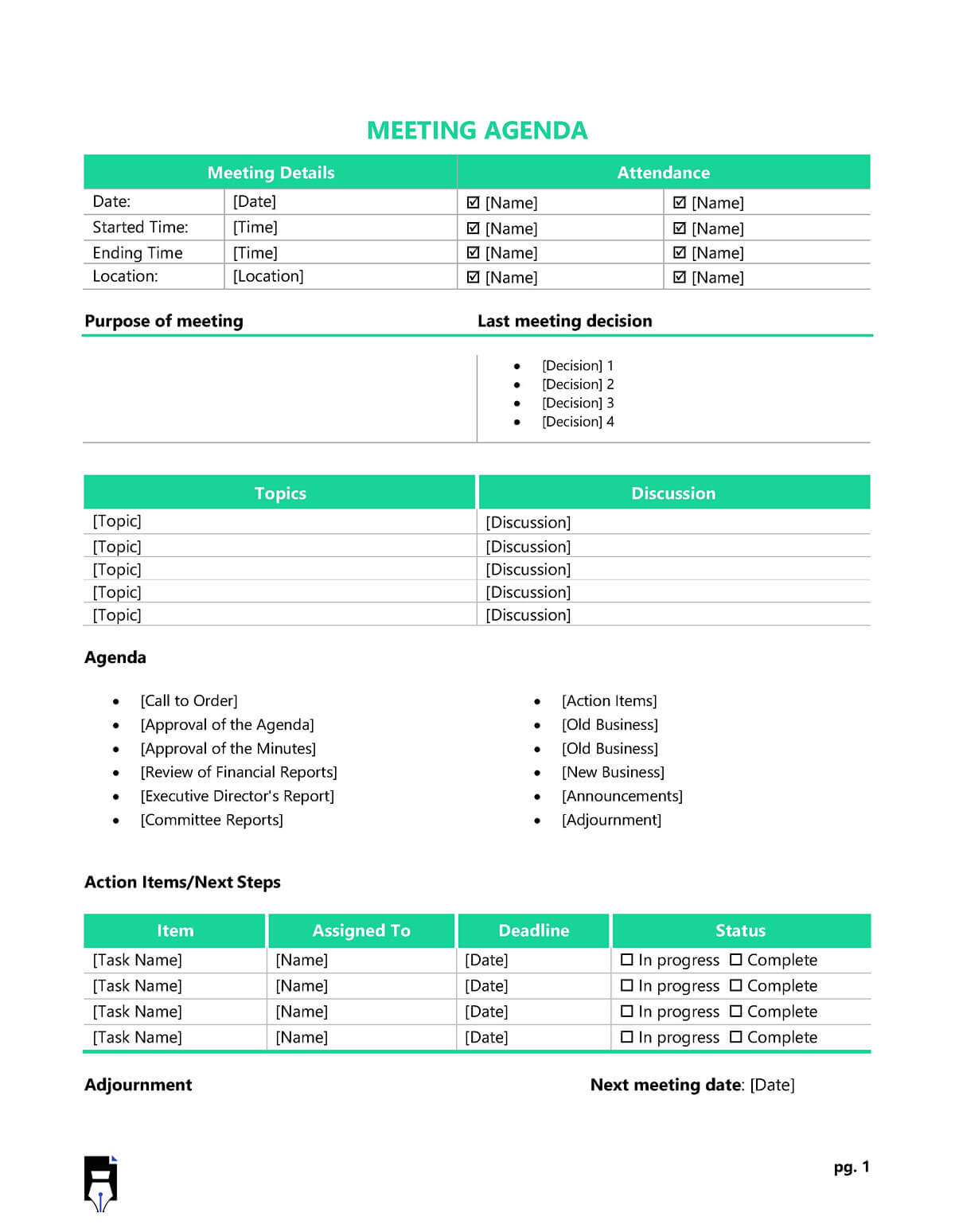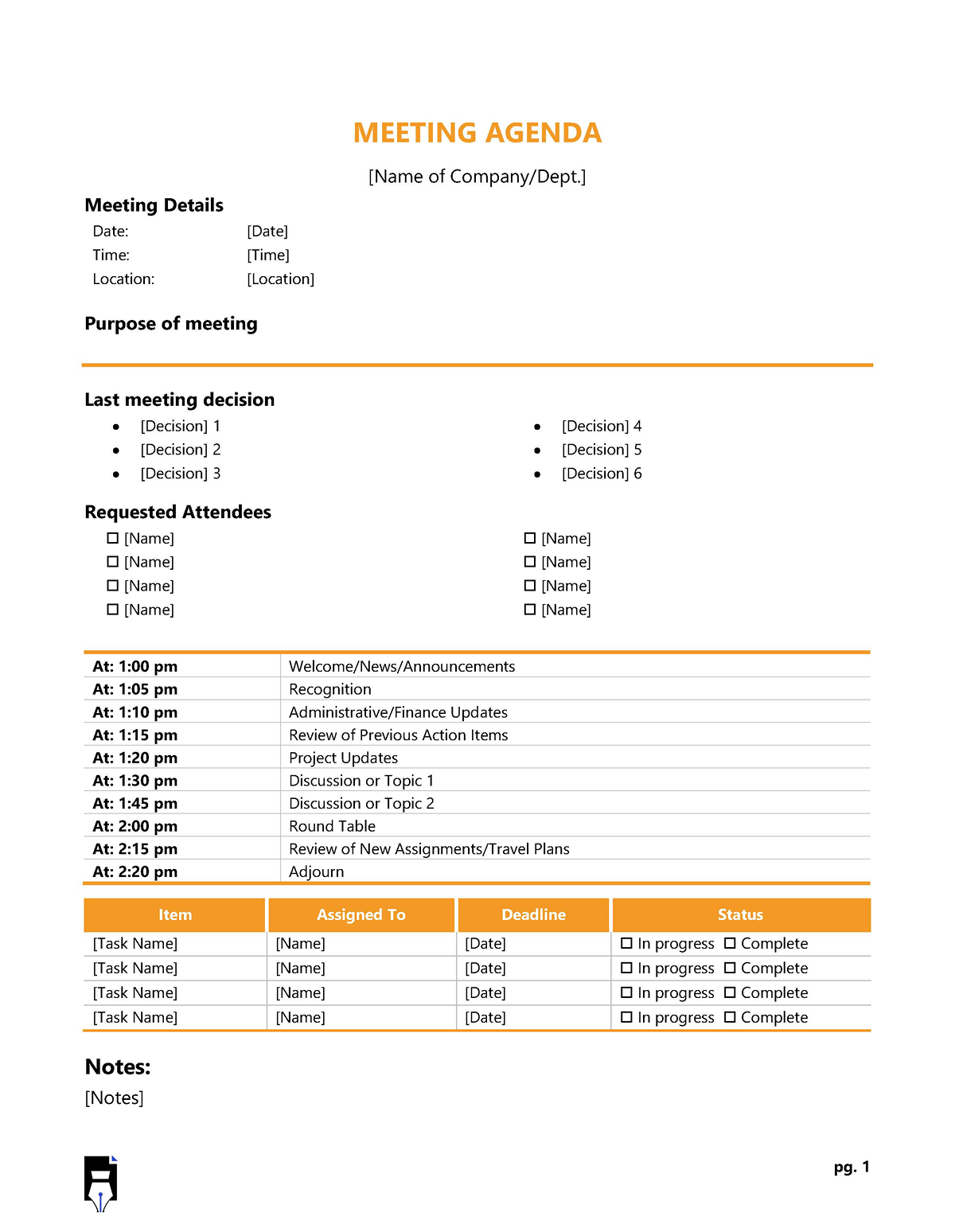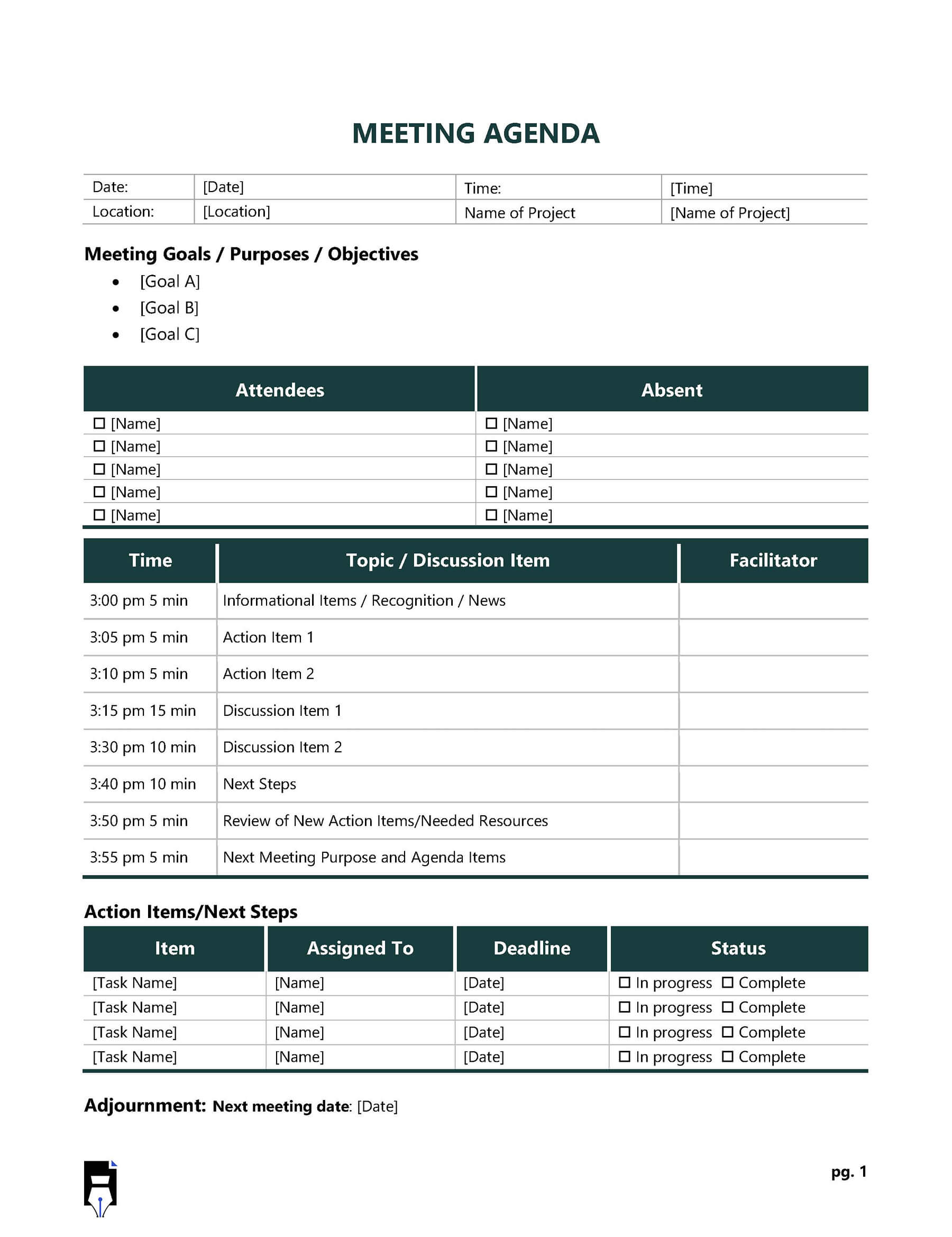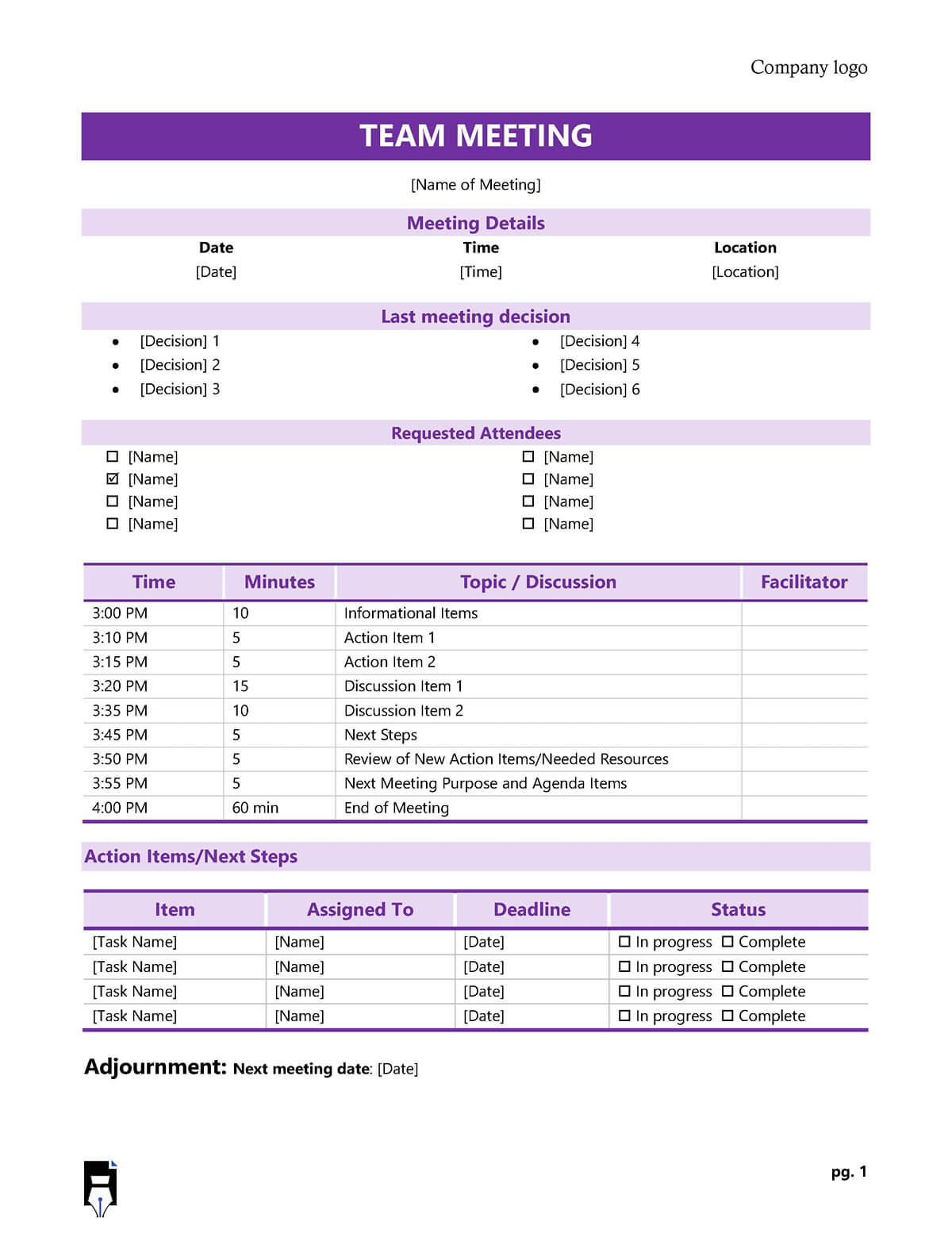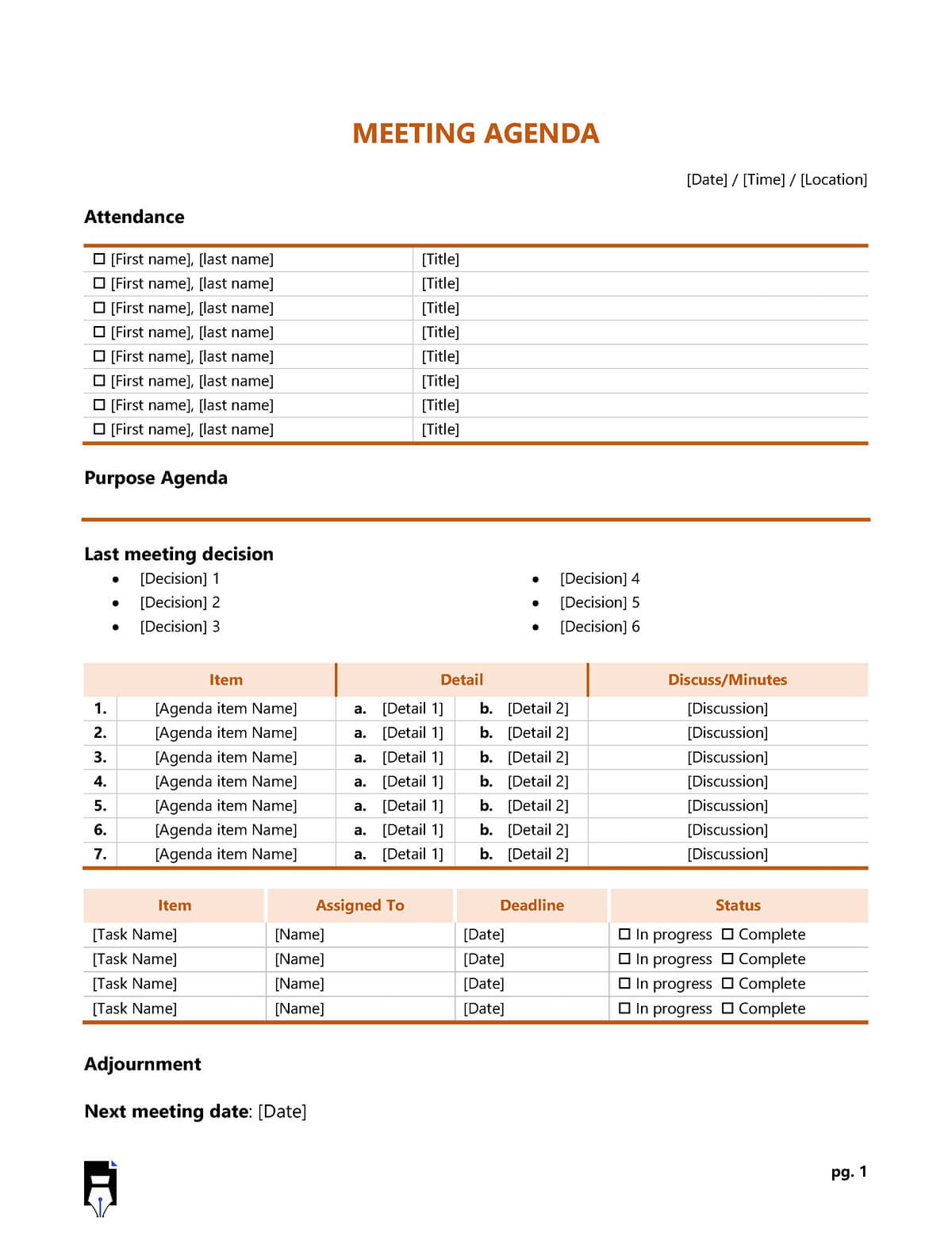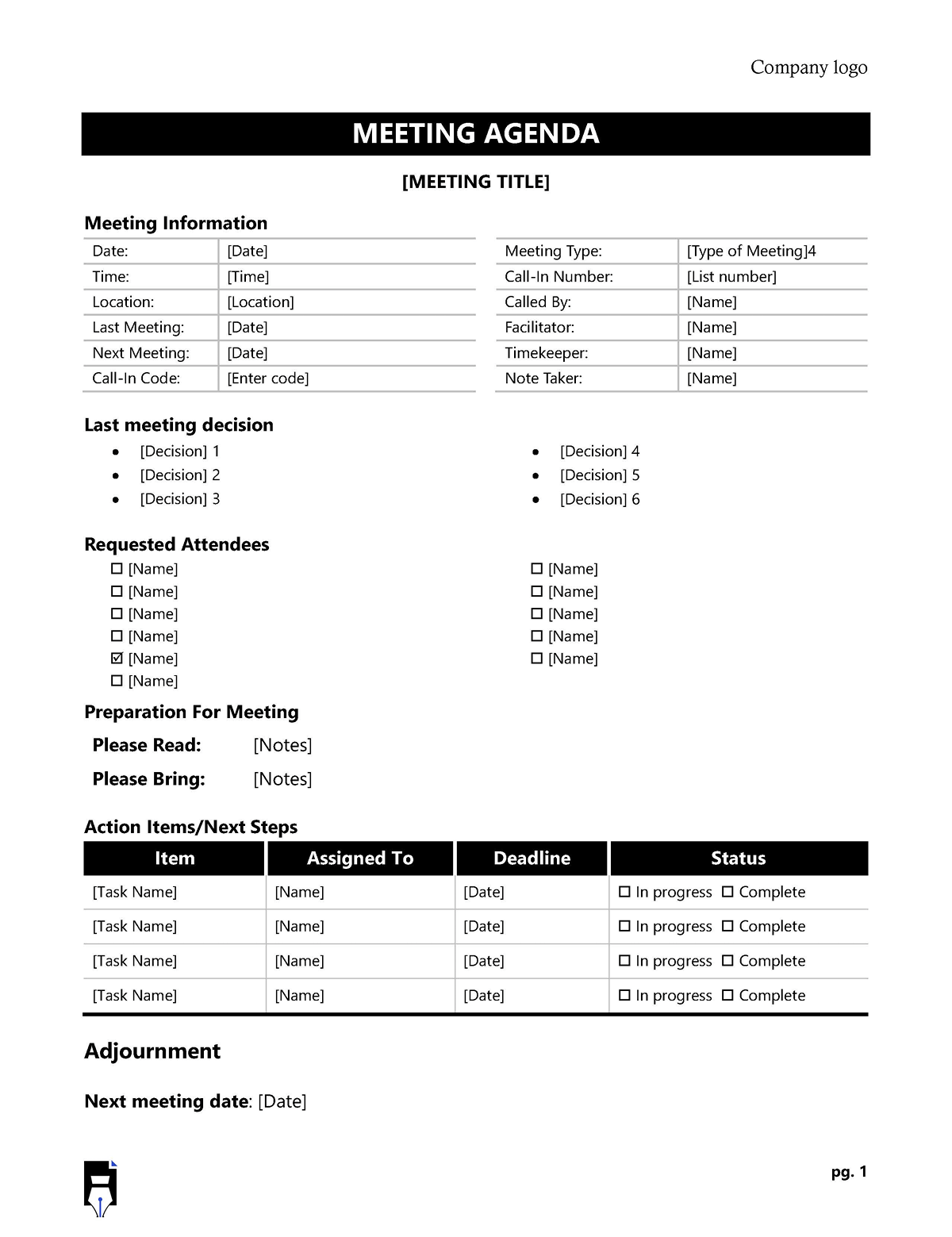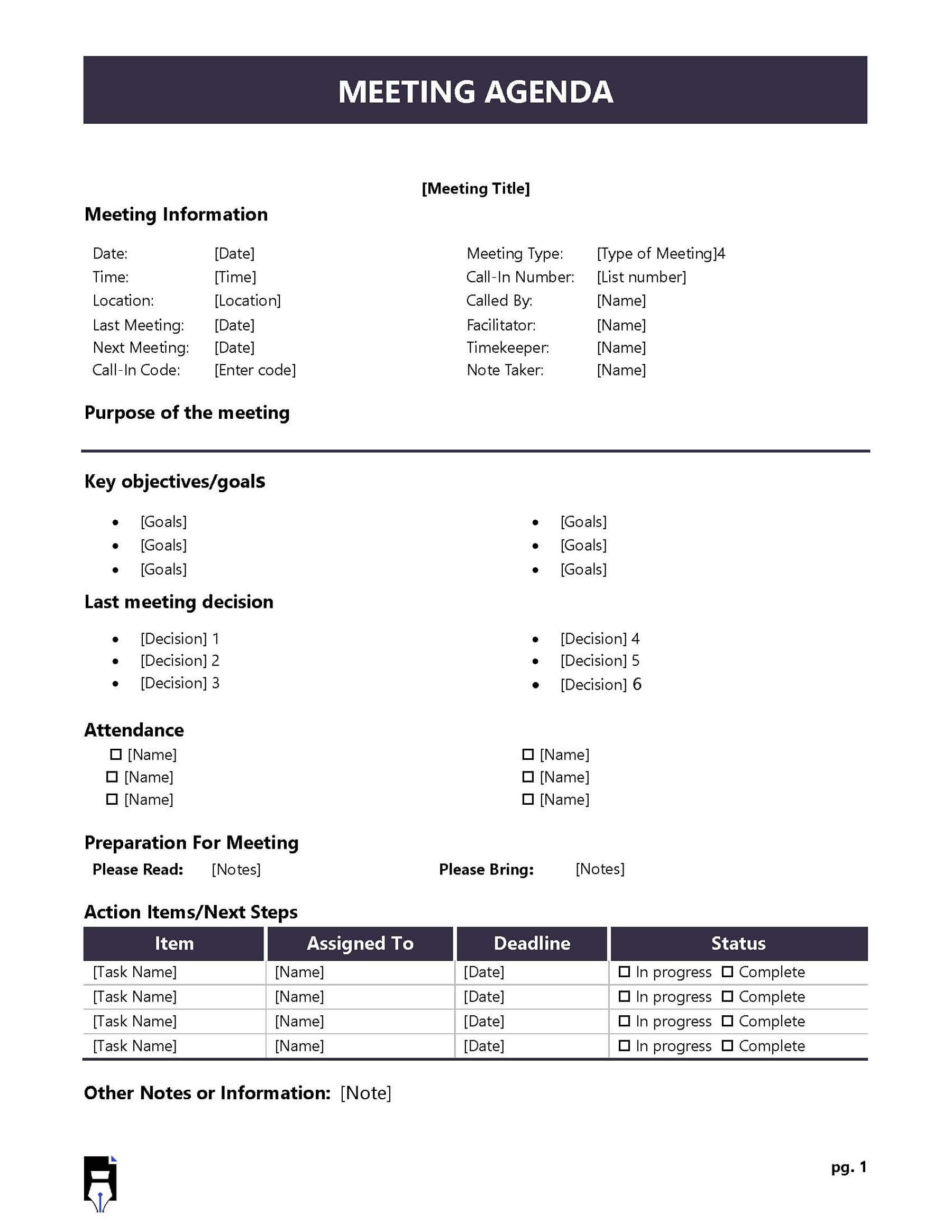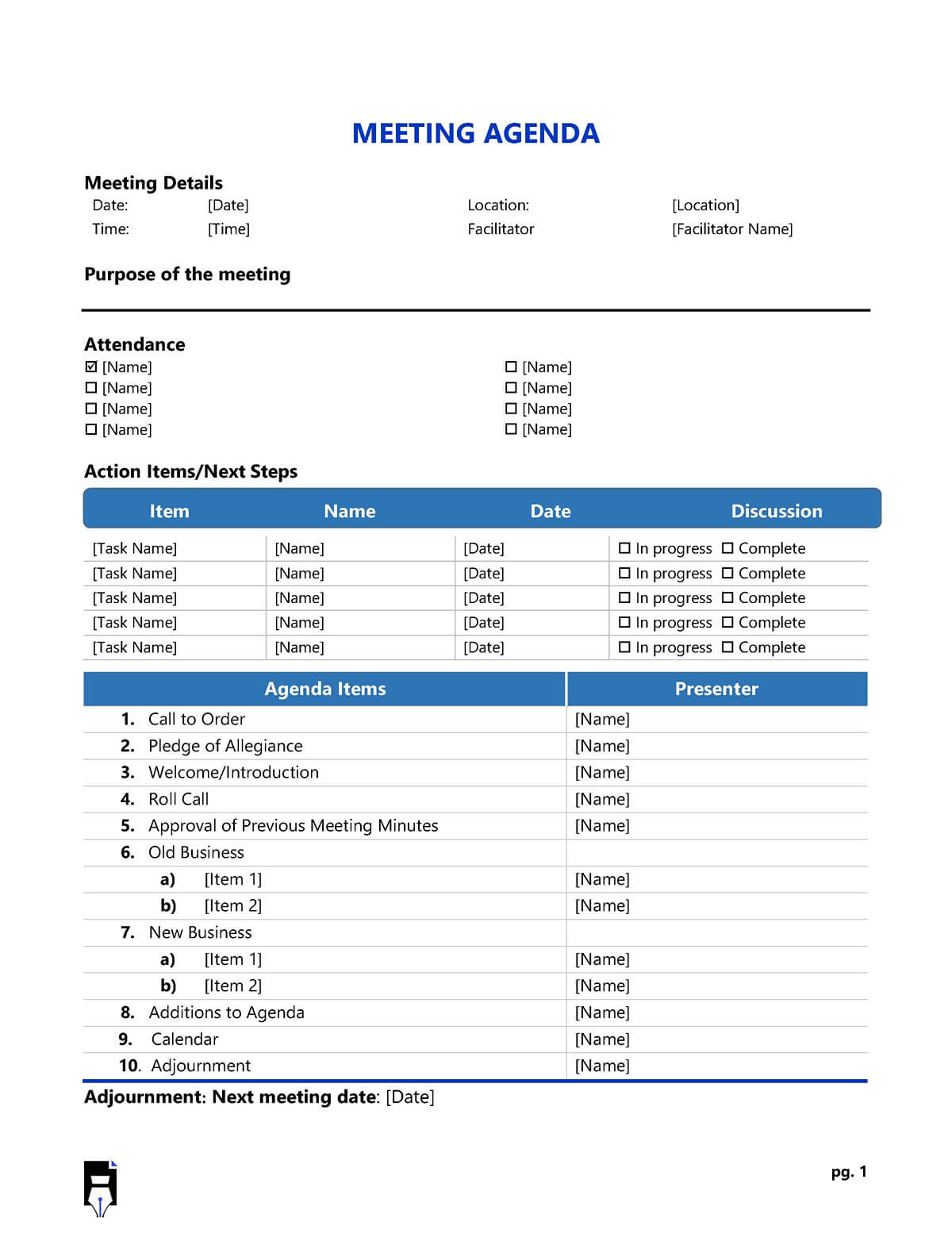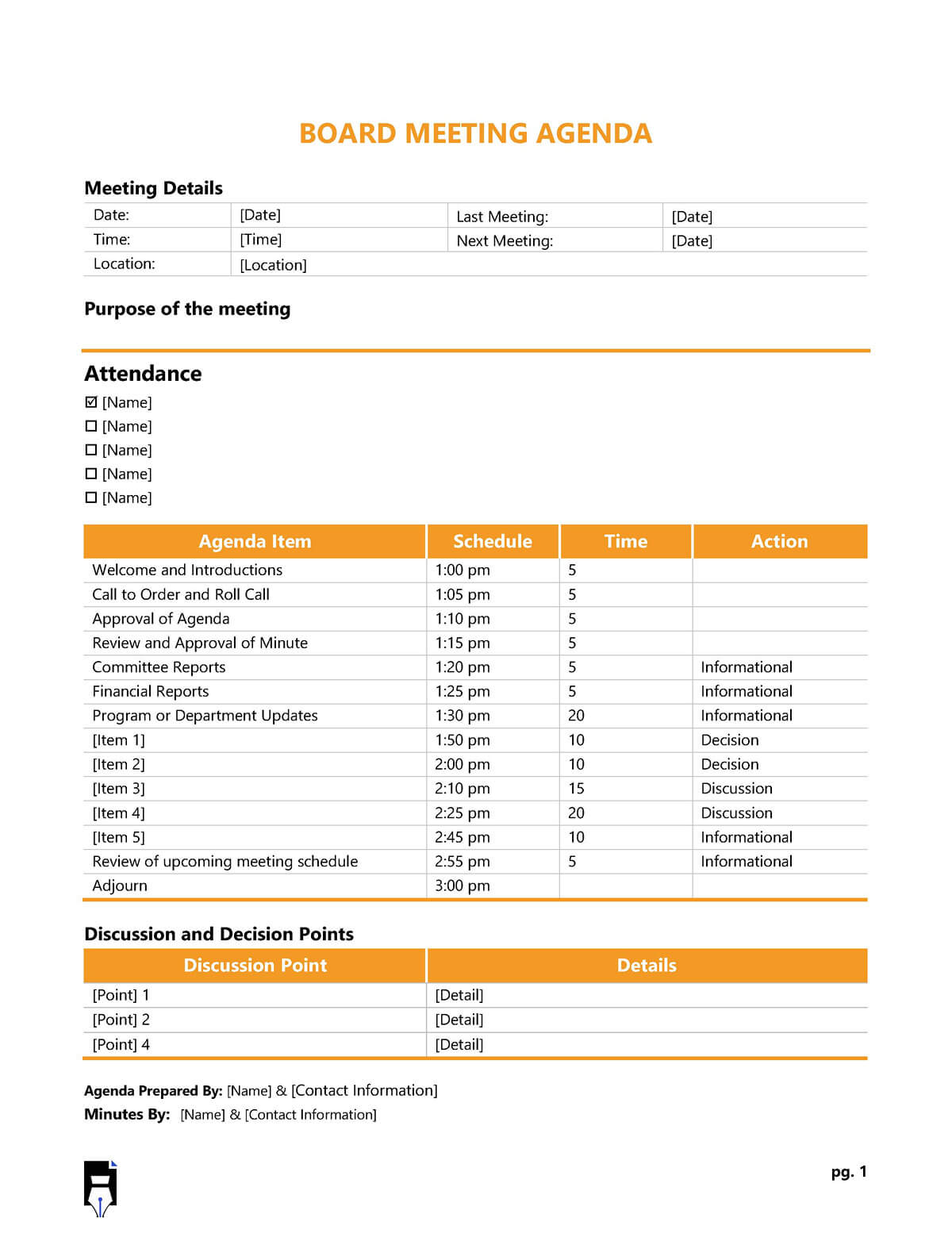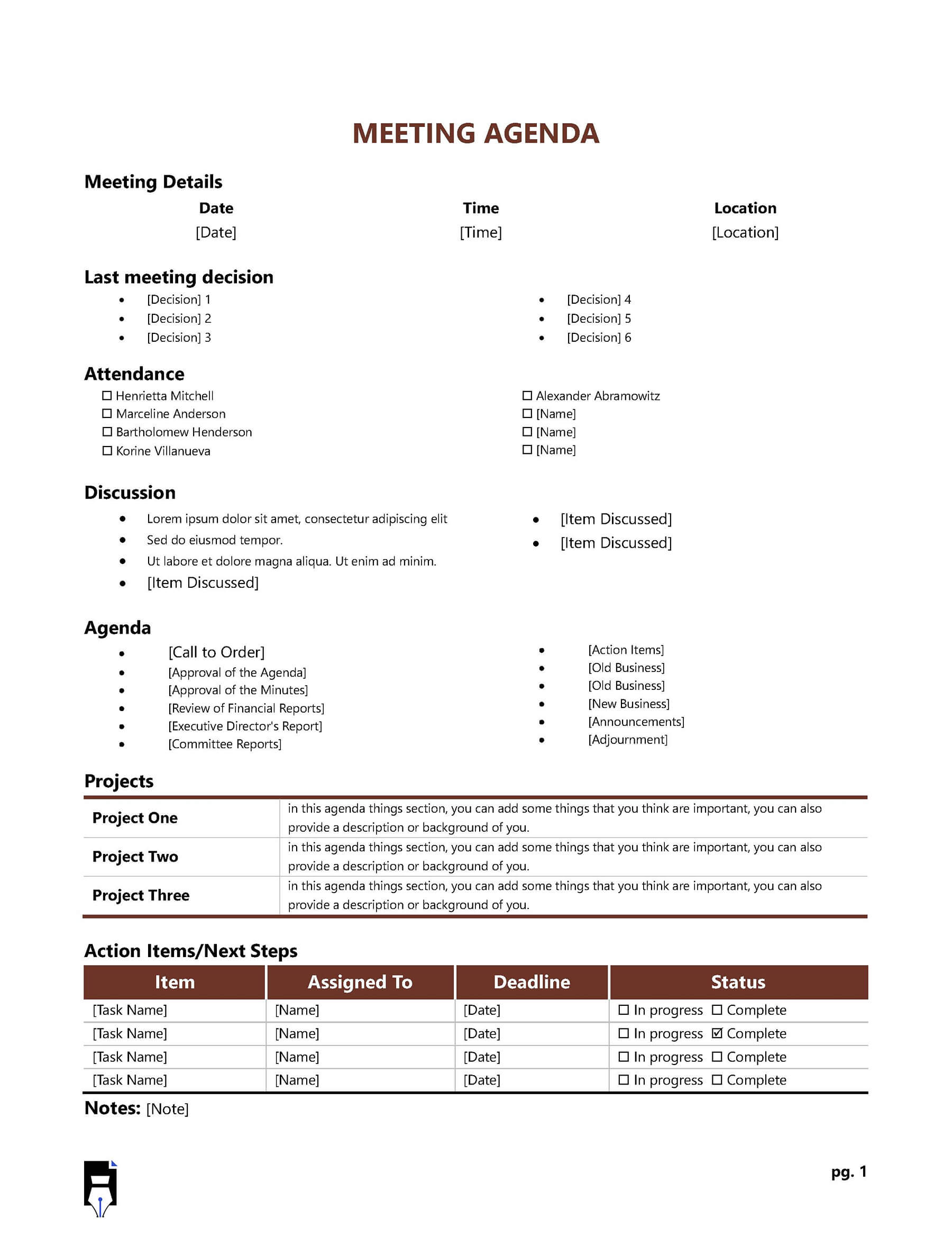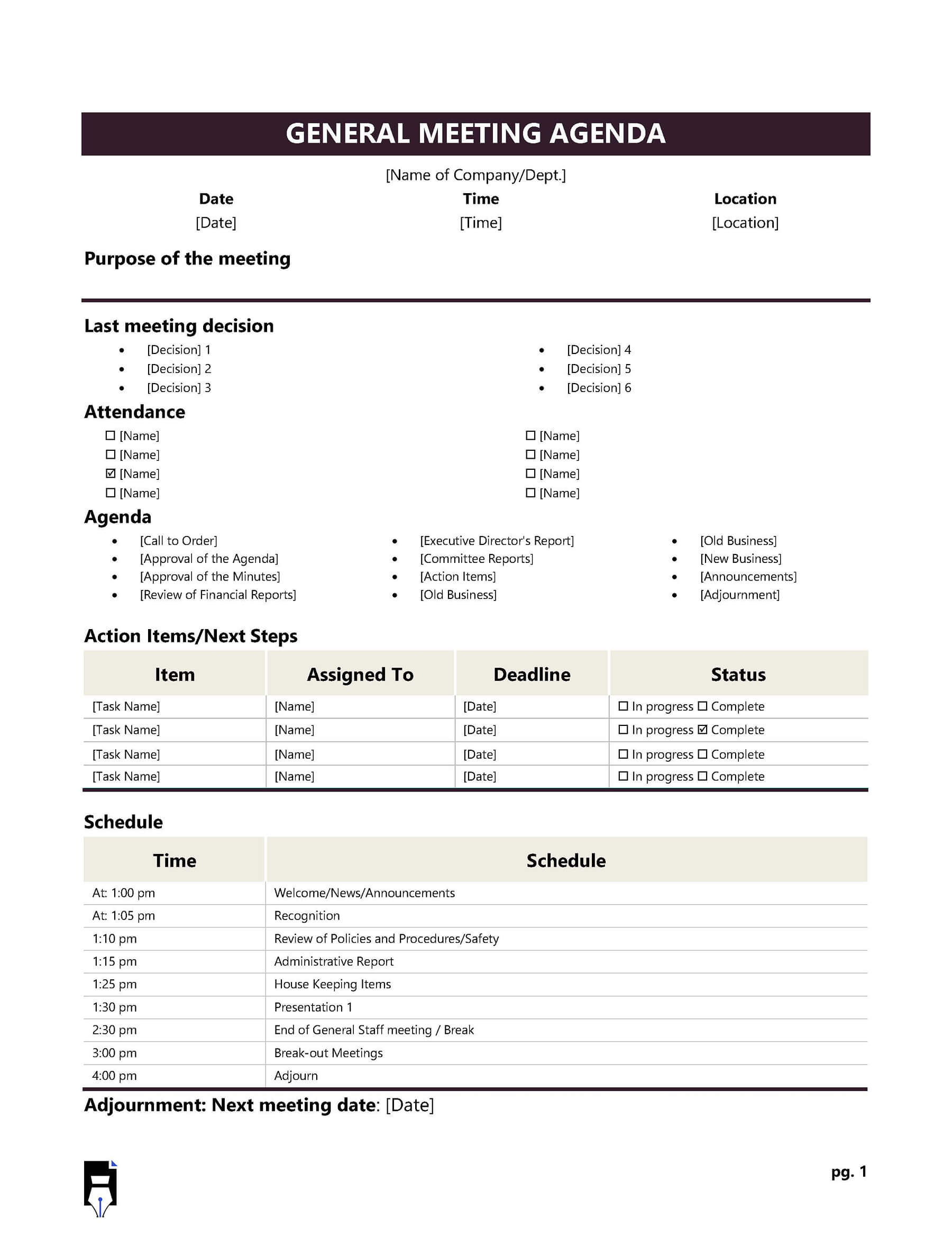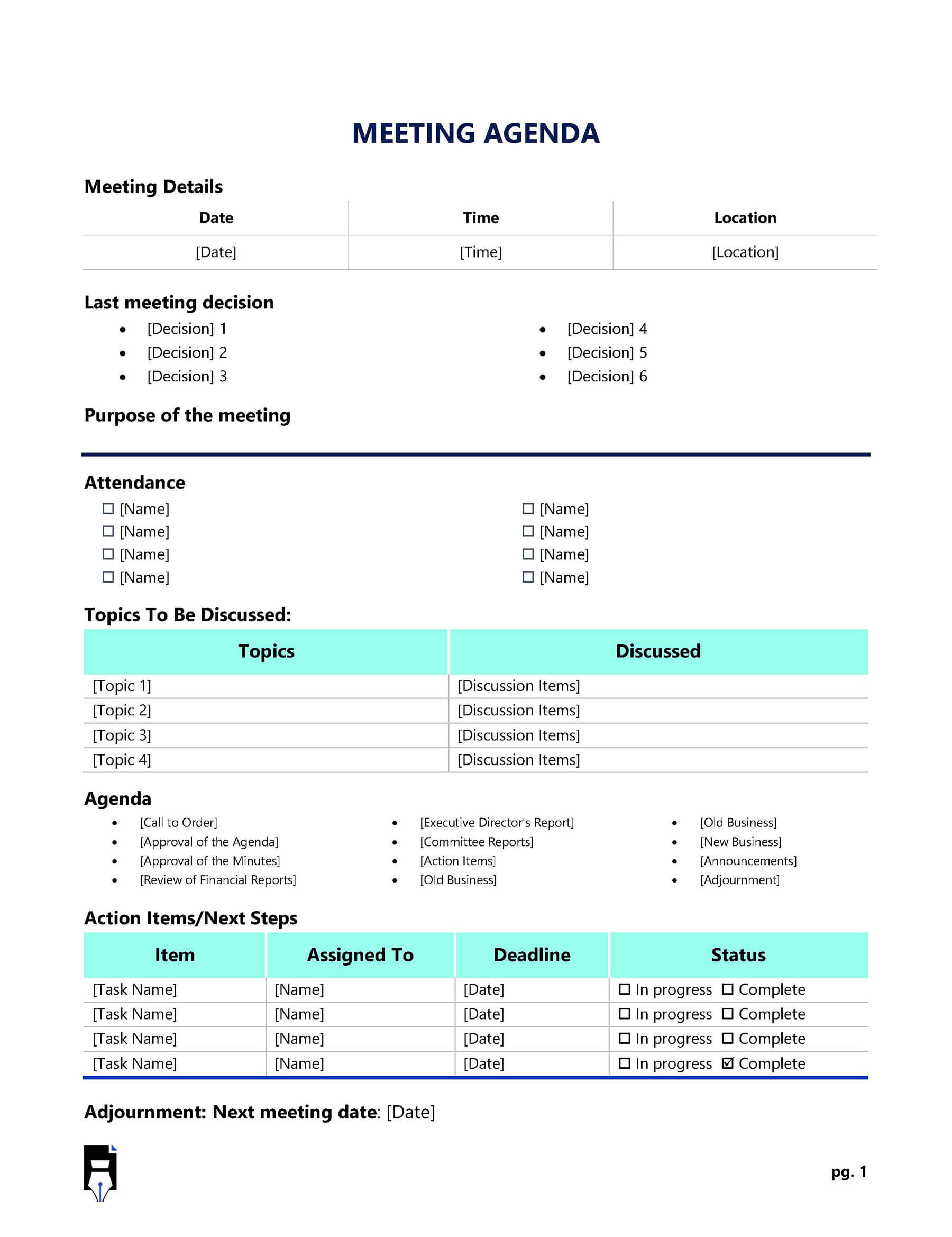Successful meetings are held with predetermined objectives. This guarantees that everyone who attends the meeting is on the same page and every minute of the meeting is productively utilized. A meeting agenda is an organized plan enlisting matters to be addressed in the meeting. This way, attendants can understand what is expected of them before and during the meeting. A meeting agenda template typically include the title of the meeting, attendees list, meeting purpose, location, main themes, talking points, action items, and activities. Once it is clear what the meeting will be about, each agenda item can be allocated enough time.
An agenda can be used by ‘staff,’ ‘team,’ or ‘board’ members, etc., as it can be used for all types of meetings. However, the meeting organizer creates the agenda in collaboration with other participants. The agenda must be set for the participants for approval before the meeting. On the day of the meeting, the chairperson leads the team as they jointly discuss and complete the stipulated tasks. The agenda is then added to the meeting minutes.
This article guides creating a free template for a meeting agenda in MS Word, its format, and key elements. It will also discuss the significance of an agenda of a meeting to individuals and organizations.
Free Templates
Given below are meeting agenda templates:
Why You Should Use an Agenda Template for Productive Meetings
Employees hold meetings to achieve a common goal. An agenda is a good way to define the purpose of a meeting beforehand. The meeting could be an emergency, progress, annual, or family meeting.
It is a roadmap of how the meeting will be undertaken. With a defined roadmap, you can avoid distractions and ensure the time is optimally utilized. This increases productivity within the organization or team as the meeting objectives can be achieved without needing another meeting or extending it beyond the allotted duration.
It defines the responsibilities and expectations of those attending a meeting. This allows participants to plan which ideas, topics, and activities they need to present to fulfill their role adequately. This way, everyone can contribute during the meeting. It also expedites the decision-making process. An agenda is also a good reference source for what occurred during a meeting, especially when preparing meeting minutes.
While an agenda is a plan of what a meeting will be about, a meeting minutes template records what occurred during the meeting. It can be a bulleted list or a more detailed account of topics to be discussed, action items, and activities to be addressed during the meeting. It is shared with the participants before the meeting occurs to give the members sufficient time to prepare and review the topics to be discussed.
On the other hand, meeting minutes are notes of what was discussed, decisions, conclusions made, activities undertaken, and any other relevant details regarding the meeting, such as facilitator, location, time, and venue. Minutes are distributed to the members after the meeting. This is to remind the participants of the topics discussed and decisions and actions made during the meeting.
In summary, agendas are used to plan and organize meetings. Contrary, minutes are meant to record and document the events during the meeting.
Creating the Perfect Meeting Agenda Template in MS Word
When planning for a meeting, you should aim not to waste the participant’s time by having an agenda template to enlist the objectives, topics, action items, and other relevant details. Creating a free template for your meeting agenda is easy if you understand how to go about it. Below is a comprehensive procedure for creating one in MS Word.
Step 1: Launch Word and create a new document
First, you need to create a blank document. Launch Word, select “New,” and click “Blank Document.”
Step 2: Add the header
Next, you need to create the title section of the template. This information is important so that participants can schedule to be available for the meeting.
Tip: This section is meant to capture the name or type of meeting in question. The title ought to be placed at the top center of the template. This section can also capture the meeting date and time.
Step 3: Include the attendee’s list
An agenda ought to enlist the meeting participants. So, create a table with six columns and 4 rows. Select the entire first row and merge it to create one box to add the title “Attendees.” In the 1st and 4th columns, insert checkboxes; the 2nd and 5th columns should record the names of the attendees or board members, and the 3rd and 6th columns should record the titles of the attendees. Next to each name, provide the corresponding initials, which will be used later to reference the individuals in the minutes or when allocating roles. Lastly, note that the lists of attendees and absentees are important for company records to verify who was present and who was not.
Tip: The names should follow the format; [first name, last name, initials] – John Doe (JD). Center, the term Attendees. Also, adjust the sizes of the boxes to align with the information to be input.
Step 4: State the purpose of the meeting
Next, add a section to record the meeting purpose and location or connection details. This can be done by inserting a table with two rows and one column. The first row should capture the heading of this section – “Agenda.” The second row should record the purpose and location. The meeting purpose and location are needed so that the team knows what to prepare in advance and bring to the meeting.
The purpose can be written in brief but clear and informative sentences. The meeting location and connection information may not be necessary for an internal meeting. However, this information is greatly needed when planning a meeting with external parties.
Tip: First, indicate the meeting purpose, followed by the location. The purpose of the meeting should not be long; briefly state it in a few words. The location given should be specific and easy to understand.
Step 5: Enlist agenda items
The agenda items are the main points of discussion and activities. You ought to insert a table of 4 columns and a few rows depending on the number of agenda items to be included. The first column enlists the number of each item (e.g., 1, 2, 3, 4, 5, etc.). The numbers are meant to simplify referencing, as participants can always state which agenda item they are referring to when speaking. The 2nd column is where you input the name of the agenda items.
The 3rd column captures details regarding the agenda items. The items of discussion can be ideas, projects, questions, suggestions, updates on project progress, etc. Members can contribute to this list to be involved and increase the productivity of the team. These details should be succinct, factual, and quantifiable and aim to make the meeting agenda engaging enough for meaningful discussions. Also, it should be informative regarding key facts that participants should be aware of. The details are also meant to facilitate decision-making and outcomes meant to fulfill meeting objectives. The 4th column records discussions or minutes notes during the meeting.
Tip: Adjust the sizes of the columns to suit the type of information to be inserted. For example, the Details and Discussion/Minutes columns should be large enough to record detailed information and notes.
Step 6: Add action items and item owners
Afterward, add another block for recording the action items and meeting outcomes. Insert a table of 4 columns and several rows depending on the number of action items you need to input. Select the entire first row and merge the columns. Label this block as “Agenda Items/Unresolved Issues.” Then, label the 4 columns as “Item,” “Owner,” “Due,” and Status,” respectively. Here you can assign roles to participants and specify each action item’s due date and status. This increases accountability among the members.
Tip: Action items can be itemized and numbered to simplify referencing. It is important to enlist all the supporting documents needed for the meeting, as it will help the board meeting members to review them. This way, everyone has enough information to contribute to the meeting.
Step 7: Save and share the template
Lastly, save the template and distribute it to the meeting participants. Also, inform the participants that they can add relevant talking points to the agenda before the meeting date.
Note: As already established, templates are efficient tools for creating meeting agendas. You can create your own, as discussed above. However, if this process proves to be complex and time-consuming, you can use premade ones. They can be downloaded from our site. They are professionally designed to incorporate all the necessary elements needed in an agenda. Also, these templates are free, downloadable, and easy to personalize. This approach saves you time and energy.
Use Case of Meeting Agenda Templates
Templates can be utilized for preparing agendas for various types of meetings. Their reusability is essential in organizations where recurring and multiple types of meetings must be held.
Below are different use cases of such templates:
Project kickoff meeting
This type of meeting is held when launching a new project. It is meant to verify that everything is in order to start the project. The agenda for such a meeting will outline the project objectives, deliverables, roles and responsibilities of board members, constraints, and timelines.
HR meeting
The HR department holds an HR meeting as a team building exercise where participants discuss the challenges of company staff. An agenda for such a meeting will outline the activities to be done during the meeting, issues raised by staff, and ways forward.
Project management meeting
A project management meeting brings all the project stakeholders together to discuss the project’s progress, successes, and challenges. The agenda will include objectives, project updates, roadblocks and risks, deadlines, major milestones, and budget. The project manager facilitates this meeting.
Weekly one-on-one meetings
Weekly meetings are held to allow the team to discuss any relevant business matters. It is utilized to promote collaboration and teamwork. An agenda for such a meeting will discuss ongoing projects, successes, priorities, challenges, expectations, new projects, and feedback.
Review and Update Your Meeting Agendas
You should continuously review your template for creating agendas for meetings and identify their strengths and shortcomings. This way, you can make adjustments or updates that improve the agenda’s effectiveness. The effectiveness can be increased by improving how time is utilized during meetings and agendas are shared with the board members.
Updates can also be made to improve how information is recorded during and after the meeting. Accuracy and organization of notes are important, especially for reference purposes. Also, if changes have been made during the meeting, it is important to update the agenda. This way, people who could not attend could have an accurate account of what happened.
Conclusion
The success of a meeting may greatly depend on how well the agenda is crafted. This is why it is imperative to take time to create a comprehensive agenda. It should list the key topics of discussion and activities to be undertaken during the meeting. It should also clarify the roles assigned to the board members or participants and how long each agenda item will take.
It is advisable to use a template to simplify the process of creating an agenda for your meeting. This is because it contains the key details you should input to craft your agenda. You can create a template for each meeting or use a free generic one.
